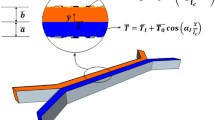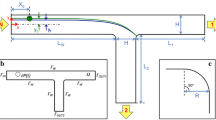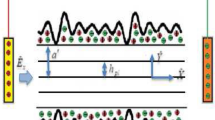Abstract
The paper is dedicated to experimental studies and numerical simulations of viscous and viscoelastic flows in microchannels. The present work investigates separation phenomena and the formation of vortical structures in two microbifurcations with one closed branch: (1) Y-bifurcation with a square cross section and (2) T-bifurcation with trapezoidal sections and small aspect ratios depth/width. The main goal of the study is to characterize the dynamics of the vortex from the vicinity of Y-bifurcation and to emphasize the changes induced by the presence of elasticity on the local path lines. Velocity measurements and flow pattern visualizations of Newtonian fluid (deionized water) and weakly elastic polymer solution (low concentration of polyacrylamide in water) are obtained using a μPIV system. Numerical computations are performed in 2D and 3D flow configurations with the commercial FLUENT code. The Newtonian simulations offer very precise descriptions of the vortical structures for all flow regimes. In the case of polymer solution, the comparison between experimental data and numerical solutions for generalized Newtonian models prove the dominant role of elasticity in modifications induced on the vortical patterns in the analyzed microgeometries. The present topic is of great interest in developing novel microfluidic applications which require precise control of the hydrodynamics of viscoelastic fluids in the vicinity of complex geometries and patterned surfaces.














Similar content being viewed by others
Explore related subjects
Discover the latest articles and news from researchers in related subjects, suggested using machine learning.References
Balan C, Legat V, Neagoe A, Nistoran D (2004) Experimental investigations and numerical simulations for an open channel flow of a weak elastic polymer solution around a T-profile. Exp Fluids 36:408–418
Broboana D, Balan CM, Wohland T, Balan C (2011) Investigations of the unsteady diffusion process in microchannels. Chem Eng Sci 66:1962–1972
Broboană D, Mărculescu C, Kadar R, Bălan C (2006) Experimental and numerical simulations of 3D branching flows, with application to the modeling of blood flow in arteries. Timişoara Med J 56:69–76
Bruus H (2008) Theoretical microfluidics. Oxford University Press, Oxford
Calin A (2008) Modeling the flow of polymeric fluids in complex geometries. PhD. Thesis, University Politehnica of Bucharest
Chakraborty S, Anand KD (2008) Implications of hydrophobic interactions and consequent apparent slip phenomenon on the entrance region transport of liquids through microchannels. Phys Fluids 20:043602
Chiang TP, Sheu TWH, Wang SK (2000) Side wall effects on the structure of laminar flow over a plane-symmetric sudden expansion. Complex Fluids 29:467–492
Chou SY, Krauss PR, Renstrom PJ (1996) Imprint lithography with 25-nanometer resolution. Science 272(5258):85–87
Chuang H-S, Gui L, Wereley ST (2012) Nano-resolution flow measurement based on single pixel evaluation PIV. Microfluid Nanofluid. doi:10.1007/s10404-012-0939-1
Cui S, Liu Y, Wang W, Sun Y, Fan Y (2011) A microfluidic chip for highly efficient cell capturing and pairing. Biomicrofluidics 5:032003
Gad-el-Hak M (2002) The MEMS handbook. CRC Press, Boca Raton
Gulati S, Dutcher CS, Lipmann D, Muller SJ (2010) Elastic secondary flows in sharp 90° micro-bents: a comparison of PEO and DNA solution. J Rheol 54:375–392
Kamholz AE, Weigl BH, Finlayson BA, Yager P (1999) Quantitative analysis of molecular interaction in a microfluidic channel: t-sensor. Anal Chem 71:5340–5347
Karniadakis G, Beskok A, Aluru NR (2005) Microflows and nanoflows: fundamentals and simulation. Springer Verlag, New York
Liu Q, Prosperetti A (2011) Pressure-driven flow in a channel with porous walls. J Fluid Mech. doi:10.1017/jfm.2011.124
Macosko CW (1994) Rheology: principles, measurements and applications. Wiley-VCH, New York
Meinhart CD, Wereley ST, Gray MHB (2000) Volume illumination for two-dimensional particle image velocimetry. Meas Sci Tech 11:809–814
Nguyen NT, Wereley ST (2002) Fundamentals and applications of microfluidics. London, Boston
Oliveira MSN, Alves MA, Pinho FT, McKinley GH (2007) Viscous flow through microfabricated hyperbolic contractions. Exp Fluids 43:437–451
Oliveira MSN, Rodd LE, McKinley GH, Alves MA (2008) Simulations of extensional flow in microrheometric devices. Microfluid Nanofluid 5:809–826
Pazourek J (1993) Three-dimensional velocity profile in channel with trapezoidal cross-section. J Liq Chromatogr Relat Tech 16:69–74
Santiago JG, Wereley ST, Meinhart CD, Beebe DJ, Adrian RJ (1998) Particle image velocimetry systems for microfluidics. Exp Fluids 25:316–319
Schlichting H, Gersten K (2000) Boundary layer theory. Springer Verlag, Berlin
Soulages J, Oliveira MSN, Sousa PC, Alves MA, McKinley GH (2009) Investigating the stability of viscoelastic stagnation flows in T-shape microchannels. J Non-Newtonian Fluid Mech. doi:10.1016/jnnfm.2009.0600
Squires TM, Quake SR (2005) Microfluidics: fluid physics at the nanoliter scale. Rev Mod Phys 77:977–1026
Stone HA, Stroock AD, Ajdari A (2004) Engineering flows in small devices: microfluidics toward a Lab-on-a-Chip. Annu Rev Fluid Mech 36:381–411
Tsai CH, Chen HT, Wang YN, Lin CH, Fu LM (2006) Capabilities and limitations of 2-dimensional and 3-dimensional numerical methods in modeling the fluid flow in sudden expansion microchannels. Microfluidic Nanofluidic 3:13–18
Tsai Chien-Hsiung, Yeh Cheng-Peng, Lin Che-Hsin, Yang Ruey-Jen, Lung-Ming Fu (2011) Formation of recirculation zones in a sudden expansion microchannel with a rectangular block structure over a wide Reynolds number range. Microfluid Nanofluid 12:213–220
Wereley ST, Meinhart CD (2004) Micron-resolution particle image velocimetry. In: Breuer KS (ed) Microscale diagnostic techniques. Springer, Berlin
Wereley ST, Meinhart CD (2010) Recent advances in micro-particle image velocimetry. Annu Rev Fluid Mech 42:557–576
Wereley ST, Meinhart CD, Beebe DJ, Adrian RJ (1998) Particle image velocimetry systems for microfluidics. Exp Fluids 25:316–319
Wereley ST, Gui L, Meinhart CD (2002) Advanced algorithms for microscale particle image velocimetry. AIAA J 40:1047–1055
White FM (1991) Viscous fluid flow. McGraw-Hill, New York
Whitesides GM (2009) The origins and the future of microfluidics. Nature 442:368–373
Whitesides GM, Stroock AD (2001) Flexible methods for microfluidics. Phys Today 54:42–48
Wörner M (2012) Numerical modeling of multiphase flows in microfluidics and micro process engineering: a review of methods and applications. Microfluid Nanofluid 12:841–886
Acknowledgments
Catalin Mihai Balan acknowledges the financial support of the CNCSIS Grant BD 73 received during his PhD work in the period 2008–2011. The experiments and numerical simulations where performed at REOROM Laboratory, Politehnica University of Bucharest. The authors are very thankful to Assoc. Prof. Ilinca Nastase, who represents the DANTEC Company in Romania and to Dr. Tiberiu Barbat for his advice in obtaining the numerical results.
Author information
Authors and Affiliations
Corresponding author
Rights and permissions
About this article
Cite this article
Bălan, C.M., Broboană, D. & Bălan, C. Investigations of vortex formation in microbifurcations. Microfluid Nanofluid 13, 819–833 (2012). https://doi.org/10.1007/s10404-012-1005-8
Received:
Accepted:
Published:
Issue Date:
DOI: https://doi.org/10.1007/s10404-012-1005-8




